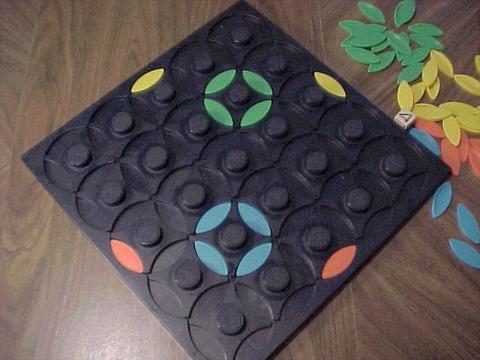The Deck of Boards
Copyright (c) 2003 Joao Neto
The Deck of Boards set (DoB) is, basically, a game system.
Introduction
What is a game system? I use the definition presented by Ron Hale-Evans: "a set of components that function together in multiple games". Game systems are, by definition, open-ended, they can be used in an infinite number of variations. The most common and impressive game system is the deck of cards: there are hundreds of games that can be played using it (like Poker, Bridge, Gin Rummy, King...). Some abstract games, due to historical and cultural reasons, are indeed families of games, like Mancala, Chess or Checkers, while not so open ended, they comprise a surprising number of different variants using the same board and set of pieces (this tell us that given enough thought, time and interest, every game can be turned into a game system).
There are also modern game systems, like James Kyle's Piecepack:

Or Andy Looney and John Cooper's Icehouse (check some games)

from www.wunderland.com/icehouse
Or Parker Brothers' Orion which is a board consisting of a 5x5 grid of rotators where fits up to four pieces of different colors:

photo by Ron Hale-Evans
While Piecepack was designed for original games, it may be used to play some well known board games (this cannot be done with Icehouse or Orion). Ron Hale-Evans present these three game systems (and a lot more) in his game systems articles (check part I, II and III).
The Deck of Boards set
The World of Abstract Games (WAG) website presents many games divided into three main groups:
|
DoB focuses on these games. It uses three concepts to construct the playing arena.
|
The field is simply a magnetic sheet:
![]()
A cell is a circle made of metal so it can attach to the magnetic field and keep the board together. Circles have the nice property that can be used to fill the plane in a square or a hexagonal tiling. They can be used to produce many kinds of boards (basically, those represented by WAG's diagram tools). I selected two types of cells:
![]()
![]()
A stone can be a marble (used in games of soldiers and kings and soldiers) or a little stackable stone (used in games of towers).
![]()
![]()
marbles and magnetic pieces
![]()
wood stackable pieces
Some board examples:
![]()
A Checkers game
![]()
A Hex game
![]()
![]()
Hexagonal boards with magnetic pieces (left) and wood pieces (right)
![]()
A Triad
board (btw, a great 3 player game)
In a sense, while WAG provides the game mental requirements, DoB provides the physical ones.
Where to buy?
Well, this is a new idea and there's no way to buy a DoB package. However you can make one: get some magnetic sheet and a square wood surface and glue them together (there is another promising material that I didn't check yet). The cells and pieces can be bought in hardware stores (I painted them with graffiti sprays). Check this eBay link for very nice marbles (check also this one). More stuff can be found at eNasco (e.g., cubes, stacking disks and double sided disks) and at Woodworks (e.g., circles, cubes, balls, pawns). Another great site is the German www.spielmaterial.de.
The boards of "Mathematical Games, Abstract Games"
If you don't which to build the system, here are PDFs for playing the games presented in the book
Games for Two: Aboyne, Amazons, Anchor, Annuvin, Campaign, Dispatch, Epaminondas, 3 Stooges, Go, Gogol, Gomoku, Gonnect, Havannah, Hex, Hobbes, Intersections, Iqishiqi, Jade, LoA, Nex, Nosferatu, Pawns, Slimetrail, SanQi, Traffic Lights, UN, Y.
Games for Three: Hex, Iqhishiqi, Porus Torus, Reversi, Triad, Triskelion.